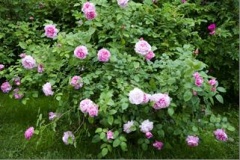Difference between revisions of "Rose, spray rose, sweetheart rose"
(Created page with "{{Infobox_Other_organic | image = Rose.jpg | origin = - | stowage factor = - | humidity and moistu...") |
|||
| Line 27: | Line 27: | ||
<b>Sources used</b><br> | <b>Sources used</b><br> | ||
BMT De [[Beer]]’s Consolidated Manual on (Dutch) [[Flower Bulbs]], cut flowers/greens and potted [[plants]] | BMT De [[Beer]]’s Consolidated Manual on (Dutch) [[Flower Bulbs]], cut flowers/greens and potted [[plants]] | ||
| + | |||
| + | [[Category: Products]][[Category: Perishables]] | ||
Revision as of 14:22, 16 August 2013
| Infobox on Rose, spray rose, sweetheart rose | |
|---|---|
| Example of Rose, spray rose, sweetheart rose |  |
| Facts | |
| Origin | - |
| Stowage factor (in m3/t) | - |
| Humidity / moisture | - |
| Ventilation | - |
| Risk factors | See text |
Rose, spray rose, sweetheart rose
Contents
Description / Shipment / Storage / Risk factors
Scientific Name and Introduction
Rosa cvs, hybrids. The rose undoubtedly remains the queen of the cut flowers. The historical association of this flower with romance and beauty ensures that roses will continue to be a highly desired cut flower in the future. Properly handled, most of the commercial cut roses will easily last in the vase for 10 days. Unfortunately, many consumers consider roses to have a very short vase-life. This is partly because poor water uptake by certain cultivars of purchased roses all too often results in the symptom called "bent neck" in which the flower neck wilts, and the bud fails to open. We also have found that many commercial cultivars are quite sensitive to ethylene gas. The cut flower industry has an important stake in overcoming the poor postharvest reputation of the cut roses. All that is required is proper postharvest care for those cultivars susceptible to bent neck, and appropriate pre-treatment of those that are sensitive to ethylene, especially if they are to be sold in supermarkets or other ethylene polluted areas.
Quality Characteristics and Criteria
Roses are harvested at different levels of maturity, depending on marketing and cultivar. For long-distance transport or storage, roses should usually be harvested with some of the sepals reflexed. Flowers harvested before the sepals reflex may fail to open, or may be more susceptible to bent neck. Fast-opening roses, like some yellows and whites, should be harvested just before the sepals start to separate from the bud. The marketing life of roses harvested later will be reduced unless extra care is taken with their postharvest handling. Harvesting is most convenient using shears provided with auxiliary jaws to hold the bloom after harvest. The cut is normally made so as to leave 2 five-foliate leaves below the cut. When stem length is an important consideration, the cut may be made below Roses should be purchased and sold by cultivar name. Avoid blooms that are already open; flowers should normally have some or all of their sepals (the green protective leaves at the base of the flower) folded back, but the petals should not have started unfolding. Brown spots or patches on the outer petals may be an indication of Botrytis infection.
Grading and Bunching
Objective grading is based on stem length; subjective grading is based on flower maturity, stem straightness, stem caliper, and quality of flower and foliage. Defects on the outer "guard" petals are not normally a cause for down-grading, because these petals are removed by the retail florist. Leaves and thorns may be removed manually or mechanically if desired. This operation has little effect on vase-life if flowers are placed in an effective preservative. The number of stems per bunch, and bunch pattern (single layer, staggered two-layer) depends on market preferences.
Ethylene Sensitivity
Some cultivars are ethylene sensitive. Treat with 1-MCP or STS if they are being distributed through the mass markets, especially if being shipped through distribution centres, and also treat to prevent the effects of the ethylene prior to dry storage.
Pretreatments
Roses should be pre-treated with 1-MCP or STS to prevent the effects of ethylene, especially if they will be sold through a supermarket. Sugar-containing pre-treatments are not particularly useful for roses. Re-hydrate after cutting, storage, and on arrival at the retail outlet with a re-hydration solution. Commercial re-hydration solutions are effective, or you may use clean water containing 50 ppm hypochlorite, preferably below pH 5,0. This solution has proved safe, and is inexpensive, so the buckets can be filled to the desired 20 to 30 cm deep.
Storage Conditions
Roses should be stored dry at 0°C to 1ºC. Roses intended for long-term storage should be packed in polyethylene-lined cartons and pre-cooled. They may be held for up to 2 weeks in dry storage if the temperature is maintained close to the freezing point.
Packing
Rose bunches are routinely sleeved in plastic, waxed paper, or soft corrugated card sleeves. The ‘spiral’ bunch used by many off-shore producers increases the difficulty of pre-cooling the flowers, and the opportunity for condensation collecting on the outer petals. Botrytis infection is a common result of the presence of free moisture on the petals of cut roses.
Special Considerations
Removal of those leaves and thorns below the water line should not reduce vase-life if stems are placed into a preservative solution. The fungus Botrytis represents a major problem for roses. Symptoms of Botrytis infection include brown blotches on petals and gray, fuzzy growth on leaves, stems or flowers. Postharvest fungicide dips can be helpful - use only registered products according to label instructions. Petal blackening on some red cultivars is due to growing conditions, and cannot be corrected at wholesale or retail levels.
Sources used
BMT De Beer’s Consolidated Manual on (Dutch) Flower Bulbs, cut flowers/greens and potted plants











